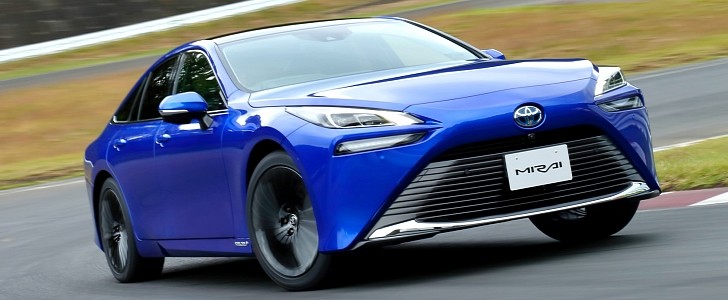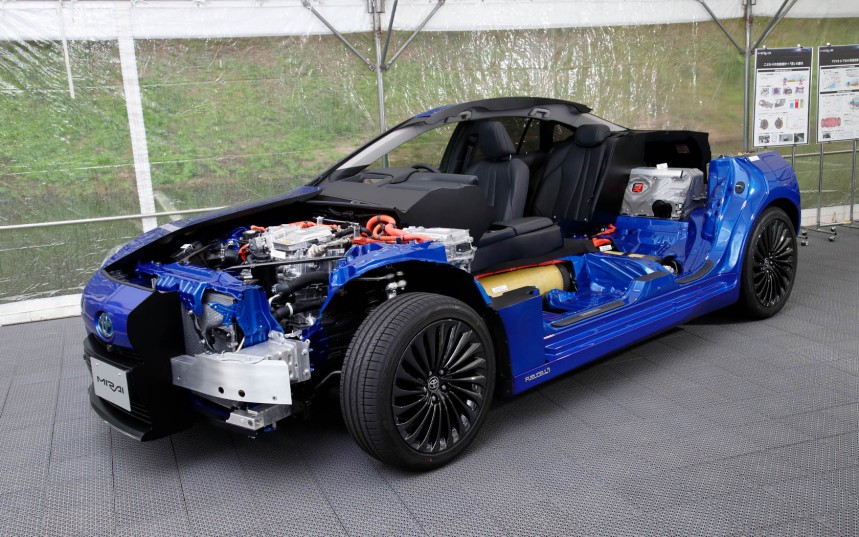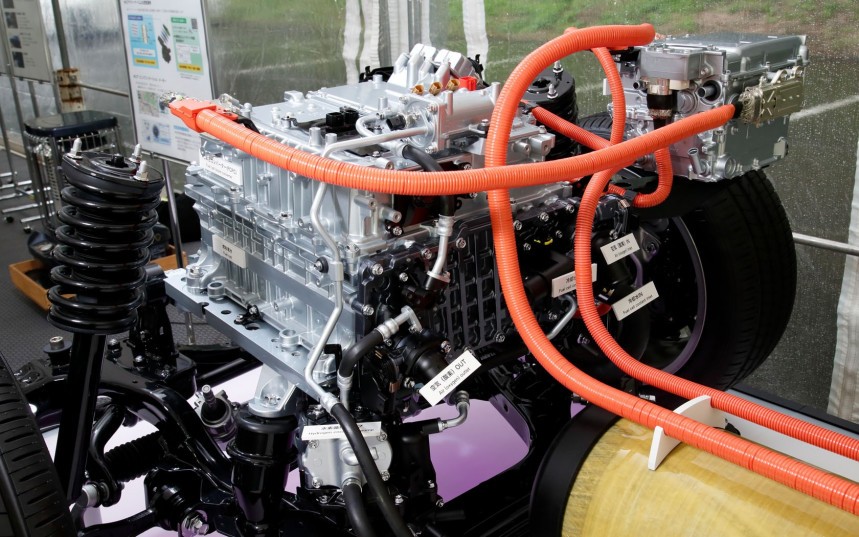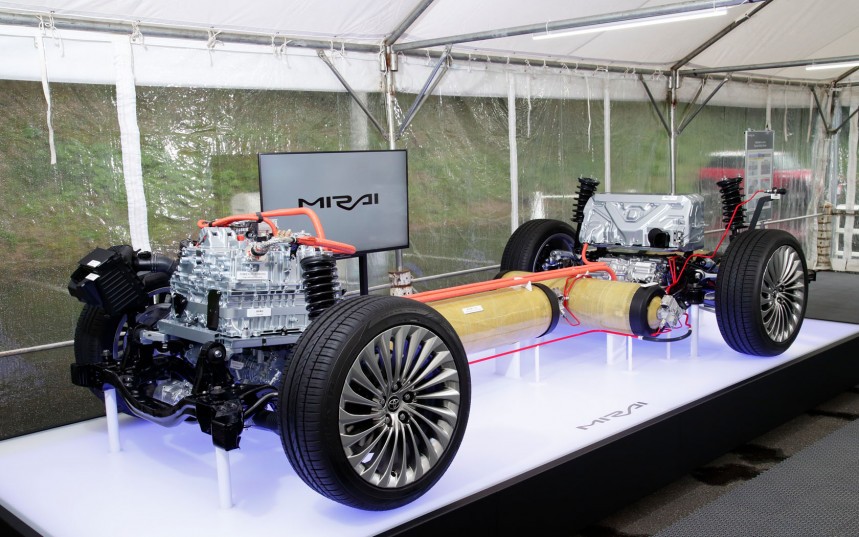After the success of the first generation, the Japanese manufacturer launched an all-new version of the Mirai. The hydrogen-powered car received a much-needed visual makeover, but more importantly, the chassis and fuel system have also received significant upgrades.
Fuel cell electric vehicles (FCEV) offer a viable zero-emission alternative to their battery electric counterparts. They work by using a complex fuel cell system that converts hydrogen into electric power and uses it to drive the vehicle. `
The fuel range is superior to most electric cars, and refueling is required, with the process taking about the same amount of time as it would with a conventional ICE-driven car.
This is a major advantage over BEVs that still take more time to recharge, even with the latest advancements in fast charging technology and high voltage electrical systems.
The downside is that refueling stations are not as widespread as charging stations, but many countries including the U.S., are planning to rapidly expand their networks to accommodate the growing number of FCEVs.
The second-generation Toyota Mirai promises to be the most advanced fuel cell vehicle out there. It was completely redesigned recently, looking much more appealing than its predecessor.
It is built on Toyota’s sporty GA-L platform, which it shares with the Lexus LC and LS aiming to deliver increased stability and improved handling.
The redesigned chassis is manufactured using the latest building methods and materials like aluminum to improve weight saving or high strength steel plates for increased rigidity.
It features an enlarged rocker cross-section, additional rear floor cross members, and die-cast aluminum suspension towers bonded together using high-quality adhesives and the latest laser-welding technologies.
To provide increased comfort, stability, and maneuverability, the suspension system was also redesigned. The front axle uses a high-mounted multi-link setup while the rear employs the same layout mounted at a lower point to provide space for the battery pack and electric motor. New shock absorbers with specifically tuned damping settings were also added.
The fuel cell stack, which sits at the heart of the system, uses electro-chemical reactions to convert the hydrogen fuel into electric energy.
The unit is more compact and lightweight compared to its predecessor and is protected by an extruded aluminum frame. It has been moved to the engine bay along with the boost converter and power control unit to increase cabin and trunk space.
The high-powered electric motor now stands on the rear axle and provides rear-wheel drive, a major change compared to the front-wheel-driven first generation. It is also more powerful, delivering up to 182 PS (134 kW; 179 HP). It uses a lithium-ion drive battery that is also located in the rear and stores energy recovered during braking and deceleration.
The new Mirai uses three high-pressure hydrogen tanks instead of the two used by its predecessor. One is integrated into the central chassis tunnel, while the other two are placed under the rear floor.
This layout provides more cabin space, and the additional tank increases the car’s range to 750 or 850 km (466 or 528 miles), depending on the chosen trim.
The tanks are covered with reinforced carbon fiber resin and use a highly advanced leak detection system comprised of several sensors and a fusible plug valve that releases hydrogen in case of an accident to prevent a rupture.
Toyota’s all-new FCEV was recently launched in Japan, and it will soon be available in other markets. The carmaker expects a tenfold expansion in sales volume, reducing its base price by approximately 20%.
With the rapid global expansion of hydrogen refueling infrastructure, FCEVs are becoming an attractive alternative to conventional battery-powered EVs, offering double the range in some cases without having to worry about losing precious time recharging.
The fuel range is superior to most electric cars, and refueling is required, with the process taking about the same amount of time as it would with a conventional ICE-driven car.
This is a major advantage over BEVs that still take more time to recharge, even with the latest advancements in fast charging technology and high voltage electrical systems.
The downside is that refueling stations are not as widespread as charging stations, but many countries including the U.S., are planning to rapidly expand their networks to accommodate the growing number of FCEVs.
The second-generation Toyota Mirai promises to be the most advanced fuel cell vehicle out there. It was completely redesigned recently, looking much more appealing than its predecessor.
The redesigned chassis is manufactured using the latest building methods and materials like aluminum to improve weight saving or high strength steel plates for increased rigidity.
It features an enlarged rocker cross-section, additional rear floor cross members, and die-cast aluminum suspension towers bonded together using high-quality adhesives and the latest laser-welding technologies.
To provide increased comfort, stability, and maneuverability, the suspension system was also redesigned. The front axle uses a high-mounted multi-link setup while the rear employs the same layout mounted at a lower point to provide space for the battery pack and electric motor. New shock absorbers with specifically tuned damping settings were also added.
The fuel cell stack, which sits at the heart of the system, uses electro-chemical reactions to convert the hydrogen fuel into electric energy.
The high-powered electric motor now stands on the rear axle and provides rear-wheel drive, a major change compared to the front-wheel-driven first generation. It is also more powerful, delivering up to 182 PS (134 kW; 179 HP). It uses a lithium-ion drive battery that is also located in the rear and stores energy recovered during braking and deceleration.
The new Mirai uses three high-pressure hydrogen tanks instead of the two used by its predecessor. One is integrated into the central chassis tunnel, while the other two are placed under the rear floor.
The tanks are covered with reinforced carbon fiber resin and use a highly advanced leak detection system comprised of several sensors and a fusible plug valve that releases hydrogen in case of an accident to prevent a rupture.
Toyota’s all-new FCEV was recently launched in Japan, and it will soon be available in other markets. The carmaker expects a tenfold expansion in sales volume, reducing its base price by approximately 20%.
With the rapid global expansion of hydrogen refueling infrastructure, FCEVs are becoming an attractive alternative to conventional battery-powered EVs, offering double the range in some cases without having to worry about losing precious time recharging.
















